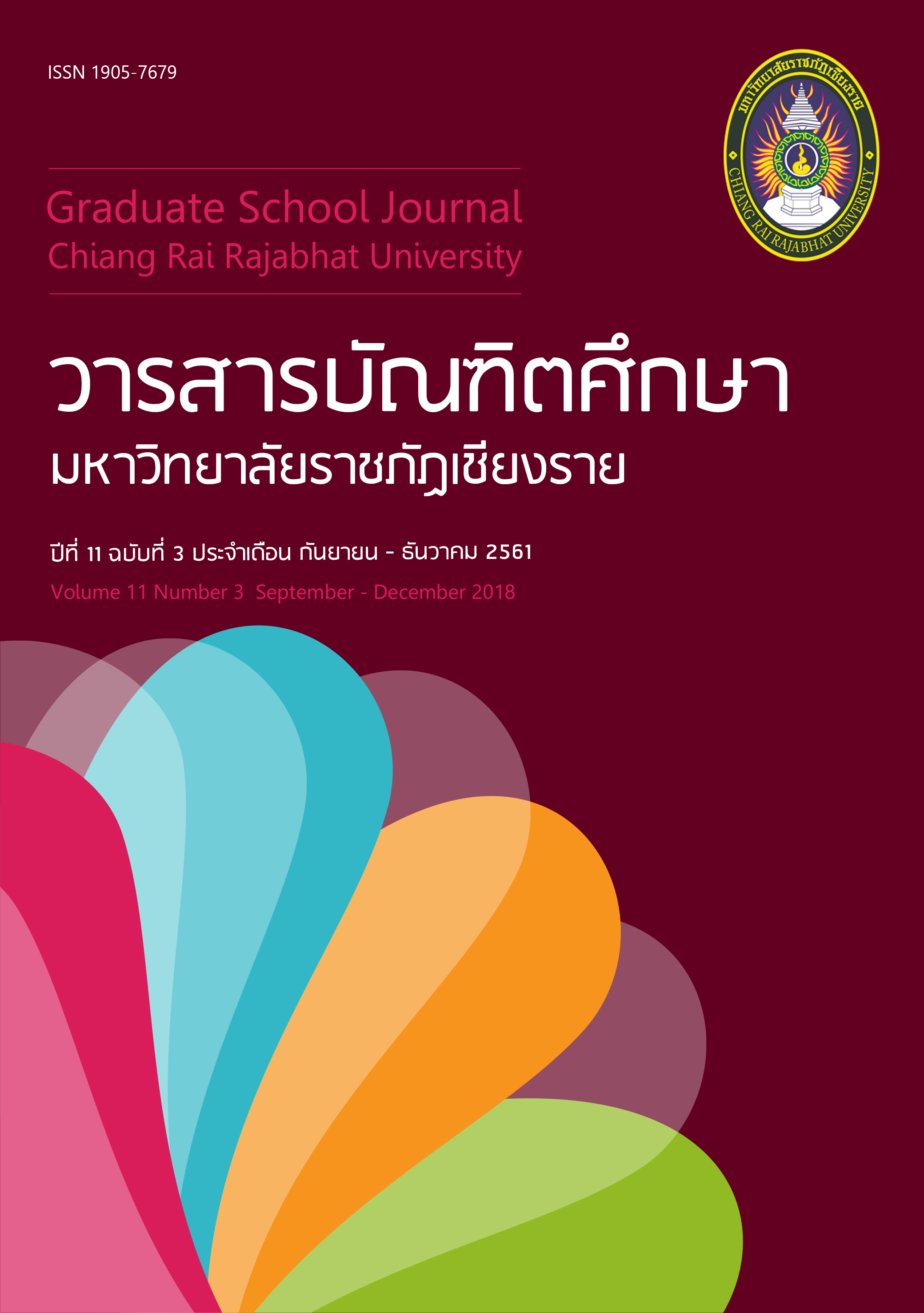The Development of Instructional Media on Thai Classifiers for Chinese Students Learning Thai at Chiang Rai Rajabhat University
Main Article Content
Abstract
The objectives of this study were to categorize the Thai classifiers inaccurately used by Chinese students learning Thai at Chiang Rai Rajabhat University, and to develop the instructional media on Thai classifiers approprite for Chinese students learning Thai at Chiang Rai Rajabhat University. The population was divided into two groups. The first was 32 third-year Chinese students from Chuxiong Normal University and 37 third-year Chinese students from Yuxi Normal University who were Chinese students learning Thai at Faculty of Humanities, Chiang Rai Rajabhat University in the academic year 2015. The second was the practice package evaluators which involved 10 lecturers teaching Chinese students at Faculty of Humanities, Chiang Rai Rajabhat University, and 32 Chinese students from Chuxiong Normal University who studied at Faculty of Humanities, Chiang Rai Rajabhat University in the academic year 2016. The research instruments were the survey form on using Thai classifiers for Chinese students learning Thai at Chiang Rai Rajabhat University and the practice package on Thai classifiers for Chinese students learning Thai at Chiang Rai Rajabhat University. The data was analyzed by descriptive statistics that involved percentage and mean.
The results showed that:
1. The survey and categorization of Thai classifiers used by Chinese students learning Thai at Chiang Rai Rajabhat University indicated that the students used these classifiers inaccurately. The mistakenly used classifiers by Chinese students in descending order were reported. The first in the rank was the classifying word for “bed” with 64 errors accounted for 92.75%. The 108th word was “river” with 36 errors accounted for 52.17%. The 300th word was “notebook” with zero error. And, these classifiers were classified into 7 categories. That is, 1.1 Classifiers used for animated items were 17 words including teacher, woman, monk, abbot, nun, novice monk, princess, prince, soldier, police, engineer, creditor, peacock, monkey, sea crab, wild elephant, and domesticated elephant. 1.2 Classifiers used for unanimated and abstract items were 13 words including giant, hungry ghost, nymph, hermit, demon, precept, ghost, dish, glass, basin, coffee cup, vase, paper cup, lamp, banana leaf container, and basket. 1.3 Classifiers used for circular items were 15 words including car tire, bowl, water container, pot, belt, zip, chain, road, necklace, antenna, nail, microphone, cutter, scissor, toothbrush, firecracker, incense, and umbrella. 1.4 Classifiers used for small, thin, and long items were 19 words including hair, river, robe, ribbon, belt, zip, chain, road, necklace, antenna, electricity pole, nail, microphone, cutter, scissor, toothbrush, firecracker, incense, and umbrella. 1.5 Classifiers used for thin and flat items were 14 words including leave-taking form, movie ticket, driving license, sanitary napkin, mirror, license plate, bread, identification card, bed, credit card, leaflet, paper bag, invitation card, and practice book. 1.6 Classifiers used for classifying parts of the plants were 13 words including mushroom, bamboo shoot, cactus, jasmine, flower, carrot, lemon, orange, pomelo, mango, strawberry, corn, potato, tomato, cucumber, and radish. 1.7 Classifiers used for other items including keys, guitar, elevator, hanger, battery, bone, mask, camera, bed, glasses, tooth, airplane, iron, and kettle.
2. The development of instructional media on Thai classifiers for Chinese students learning Thai at Chiang Rai Rajabhat University in order to fix the inaccurate use of these classifiers for Chinese students learning Thai comprised 7 practice books that were constructed based on 52.7% inaccurate use of Thai classifiers by Chinese students learning Thai. The evaluation results of the developed practice books on validity and appropriateness were reported. That is, the lecturers teaching Chinese students indicated that the developed practice books were of high quality with the mean score at 4.48. Likewise, the Chinese students learning Thai indicated that the developed practice books were of high quality with the mean score at 4.50.
Article Details
บทความที่ได้รับการตีพิมพ์เป็นลิขสิทธิ์ของวารสารมหาวิทยาลัยราชภัฎเชียงราย
ข้อความที่ปรากฏในบทความแต่ละเรื่องในวารสารวิชาการเล่มนี้เป็นความคิดเห็นส่วนตัวของผู้เขียนแต่ละท่านไม่เกี่ยวข้องกับมหาวิทยาลัยราชภัฎเชียงราย และคณาจารย์ท่านอื่นๆในมหาวิทยาลัยฯ แต่อย่างใด ความรับผิดชอบองค์ประกอบทั้งหมดของบทความแต่ละเรื่องเป็นของผู้เขียนแต่ละท่าน หากมีความผิดพลาดใดๆ ผู้เขียนแต่ละท่านจะรับผิดชอบบทความของตนเองแต่ผู้เดียว
References
กรรณิการ์ ตรีวิเศษ. (2548). การเปรียบเทียบผลสัมฤทธิ์ทางการเรียนและความคงทนในการเรียนรู้ของนักเรียนชั้นประถมศึกษาปีที่ 2 เรื่อง ไตรยางศ์และการผันวรรณยุกต์ ระหว่างการสอนโดยใช้แบบฝึกทักษะกับการสอนตามคู่มือครู. (วิทยานิพนธ์ครุศาสตรมหาบัณฑิต). มหาวิทยาลัยราชภัฏนครราชสีมา. นครราชสีมา.
กันทิมา วัฒนะประเสริฐ. (2526). การศึกษาเปรียบเทียบคำลักษณนามในภาษาเชียงใหม่กับภาษา. (วิทยานิพนธ์อักษรศาสตรมหาบัณฑิต). จุฬาลงกรณ์มหาวิทยาลัย. กรุงเทพฯ.
บรรจบ พันธุเมธา. (2523). ลักษณะภาษาไทย. พระนคร: ศรีเมืองการพิมพ์.
________. (2556). ลักษณะภาษาไทย. (พิมพ์ครั้งที่ 11). กรุงเทพฯ: โรงพิมพ์มหาวิทยาลัยรามคำแหง.
พรรณี ช. เจนจิต. (2547). จิตวิทยาการเรียนการสอน : จิตวิทยาการศึกษาสำหรับครูในชั้นเรียน. (พิมพ์ครั้งที่ 6). กรุงเทพฯ: อมรินทร์การพิมพ์.
ภิญญาดา ทวีสุข. (2555). การใช้คำลักษณนามและการแปรของการใช้คำลักษณนามตามถิ่นที่อยู่ของผู้พูด:กรณีศึกษาคำลักษณนามที่ใช้ในรัฐกลันตันประเทศมาเลเซีย. (วิทยานิพนธ์ศิลปศาสตรมหาบัณฑิต). มหาวิทยาลัยทักษิณ. สงขลา.
มหาวิทยาลัยราชภัฏเชียงราย. กองวิเทศสัมพันธ์. (2556). บันทึกความร่วมมือสถานบันอุดมศึกษาระหว่างมหาวิทยาลัยราชภัฏเชียงรายกับต่างประเทศ (MOU) ปี 2556. เชียงราย: มหาวิทยาลัยราชภัฏเชียงราย.
วิไลพร จีนเมือง. (2545). การพัฒนาบทเรียนคอมพิวเตอร์ช่วยสอนเรื่องคำลักษณนาม สำหรับสอนภาษาไทยให้กับชาวต่างประเทศ. (วิทยานิพนธ์ศึกษาศาสตรมหาบัณฑิต). มหาวิทยาลัยศิลปากร. กรุงเทพฯ.
ศิวาพร ฉายชัยภูมิ. (2548). การพัฒนาชุดสื่อประสมเพื่อพัฒนาทักษะการฟังภาษาอังกฤษของนักเรียนชั้นประถมศึกษาปีที่ 6. (การศึกษาค้นคว้าอิสระการศึกษามหาบัณฑิต). มหาวิทยาลัยมหาสารคาม.มหาสารคาม.
Zhang Xiang Qun. (1995). Liang Ci Xiu Ci Shen Mei Lun. Shan Xi: Shan Xi Ren Min Chu Ban She.

